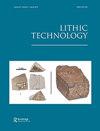Contributions and Limitations of a Technomorphometric Approach for Cleavers: The Case of Lanne-Darré (Hautes-Pyrénées)
IF 1.2
3区 社会学
Q2 ANTHROPOLOGY
引用次数: 0
Abstract
ABSTRACTResearch relating to cleavers can help to characterize the Middle Pleistocene European technocultural landscape, via a technomorphometric approach that provides insights into this tool’s composite involvement. A sample of 47 cleavers from the Lanne-Darré site were observed through two scales of technomorphometric analyses. When the studied entities are the entire tools, technomorphometric links are rarely perceptible; moreover, attributing them to specific usage is impossible given the current state of knowledge. Edge-scale analysis, however, is able to highlight significant relations between technical choices and shape. The transversal cutting edge specific to cleavers, directly resulting from the blank’s debitage, revealed recurrent morphologic and morphometric similarities, though differences remained in the nature and organization of other cleaver's parts. Four technico-structural tools groups were determined from these heterogeneous organizations, that differ from J. Tixier’s technotypology. Finally, the proposed technomorphometric approach provides new elements for understanding the structural place of cleavers in technical systems .KEYWORDS: Lower palaeolithiclithic technologycleaversLanne-Darréstructural analysisgeometric morphometryangle measurements AcknowledgmentsWe would like to thank Anne-Lyse Ravon and Vincent Mourre for their supervision of Juliette Capdevielle's Master degree, from which this work results. We would also like to thank the entire teaching staff of the ASE2P Master at the Université of Toulouse Jean-Jaurès, as well as all the members of the TRACES laboratory. Special thanks to Thomas Perrin for his help with the statistical analyses, and to Marianne Deschamps for giving us the opportunity to make 3D scans of the Lanne-Darré cleavers and for training us in the AGMT-3D software, as part of the Fyssen Morph-Axe project. Thanks to Paula García-Medrano and Antoine Muller for their help in choosing the best tool for measuring edge angles, and in using the Artefact-3D software. Thanks to Jill Cucchi for the help with the translation, and to the ChroTAll project for the support. We would also like to thank the two reviewers for their pertinent feedback, which helped to improve the article considerably.Disclosure StatementNo potential conflict of interest was reported by the author(s).切割器技术形态测量方法的贡献与局限性:以lanne - darr (hautes - pyr)为例
通过一种技术形态学方法,对刀具的综合参与提供了见解,有关刀具的研究可以帮助表征中更新世欧洲技术文化景观。通过两种尺度的技术形态分析,观察了lanne - darr遗址的47个切割器样本。当被研究的实体是整个工具时,技术形态的联系很少被察觉;此外,鉴于目前的知识状况,将它们归因于特定的用法是不可能的。然而,边缘尺度分析能够突出技术选择和形状之间的重要关系。切刀特有的横向切刃,直接由空白的碎屑造成,显示出反复出现的形态和形态测量上的相似性,尽管其他切刀部分的性质和组织仍然存在差异。从这些异质组织中确定了四个技术结构工具组,这与J. Tixier的技术类型学不同。最后,所提出的技术形态学方法为理解切割器在技术系统中的结构位置提供了新的元素。关键词:下旧石器时代技术,切割器,lanne - darr结构分析,几何形态计量,角度测量。我们要感谢Anne-Lyse Ravon和Vincent Mourre对Juliette Capdevielle硕士学位的指导,正是他们指导了这项工作。我们还要感谢图卢兹让- jaur大学ASE2P硕士的全体教职员工,以及TRACES实验室的所有成员。特别感谢Thomas Perrin在统计分析方面的帮助,感谢Marianne Deschamps给我们机会对lanne - darr切割机进行3D扫描,并培训我们使用AGMT-3D软件,这是Fyssen morpho - axe项目的一部分。感谢Paula García-Medrano和Antoine Muller在选择测量边缘角度的最佳工具和使用人工3d软件方面的帮助。感谢Jill Cucchi对翻译的帮助,以及ChroTAll项目的支持。我们也要感谢两位审稿人的相关反馈,这对文章的改进有很大的帮助。披露声明作者未报告潜在的利益冲突。
本文章由计算机程序翻译,如有差异,请以英文原文为准。
求助全文
约1分钟内获得全文
求助全文

 求助内容:
求助内容: 应助结果提醒方式:
应助结果提醒方式:


